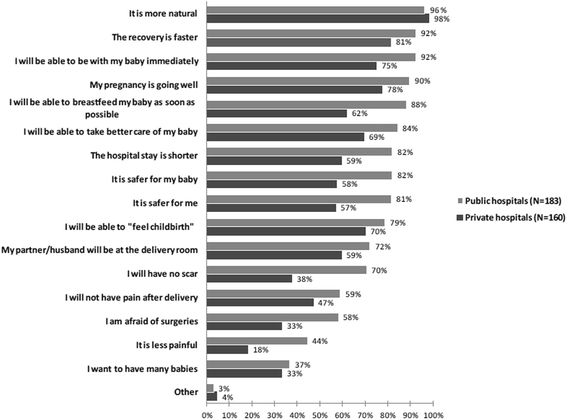Women's preferences and mode of delivery in public and private hospitals: a prospective cohort study
- PMID: 26857448
- PMCID: PMC4746891
- DOI: 10.1186/s12884-016-0824-0
Women's preferences and mode of delivery in public and private hospitals: a prospective cohort study
Abstract
Background: Rates of caesarean section have steadily increased in most middle- and high-income countries over the last few decades without medical justification. Maternal request is one of the frequently cited non-medical factors contributing to this trend. The objectives of this study were to assess pregnant women's preferences regarding mode of delivery and to compare actual caesarean section rates in the public and private sectors.
Methods: A prospective cohort study was conducted in two public and three private hospitals in Buenos Aires, Argentina. 382 nulliparous pregnant women (183 from the private sector and 199 from the public sector) aged 18 to 35 years, with single pregnancies over 32 weeks of gestational age were enrolled during antenatal care visits between October 2010 and September 2011. We excluded women with pregnancies resulting from assisted fertility, women with known pre-existing major diseases or, with pregnancy complications, or with a medical indication of elective cesarean section. We used two different approaches to assess women's preferences: a survey using a tailored questionnaire, and a discrete choice experiment.
Results: Only 8 and 6% of the healthy nulliparous women in the public and private sectors, respectively, expressed a preference for caesarean section. Fear of pain and safety were the most frequently expressed reasons for preferring caesarean section. When reasons for delivery mode were assessed by a discrete choice experiment, women placed the most emphasis on sex after childbirth. Of women who expressed their preference for vaginal delivery, 34 and 40% ended their pregnancies by caesarean section in public and private hospitals, respectively.
Conclusions: The preference for caesarean section is low among healthy nulliparous women in Buenos Aires. The reasons why these women had a rate of more than 35% caesarean sections are unlikely related to their preferences for mode of delivery.
Figures


References
Publication types
MeSH terms
Grants and funding
LinkOut - more resources
Full Text Sources
Other Literature Sources
Medical

